Invented by Michael J. Faulks, Robert Lee Popp, Michael D. Sperl, Nancy Meetz, Sandra M. Rogers, Kimberly Clark Worldwide Inc
The demand for personal wear absorbent articles for tabs is driven by several factors. Firstly, the aging population is increasing, and with it, the prevalence of incontinence. According to the National Association for Continence, over 25 million Americans experience urinary incontinence, and this number is expected to rise as the population ages. Secondly, there is a growing awareness of the importance of managing incontinence, both for physical and emotional well-being. This has led to increased demand for products that are discreet, comfortable, and effective.
Personal wear absorbent articles for tabs come in a variety of styles and absorbencies, ranging from light pads to heavy-duty briefs. They are typically made from soft, breathable materials that wick away moisture and prevent skin irritation. Many products also feature odor control technology, which helps to reduce embarrassment and promote confidence.
In addition to traditional retail channels, personal wear absorbent articles for tabs are also available through online retailers and subscription services. This has made it easier for individuals to access these products discreetly and conveniently, without having to visit a physical store.
The market for personal wear absorbent articles for tabs is highly competitive, with many brands vying for market share. Some of the leading brands include Depend, Poise, and Tena. These companies invest heavily in research and development to create products that are more comfortable, effective, and environmentally friendly.
Overall, the market for personal wear absorbent articles for tabs is expected to continue growing in the coming years. As the population ages and awareness of incontinence management increases, demand for these products is likely to remain strong. With ongoing innovation and competition, consumers can expect to see even more comfortable and effective products on the market in the future.
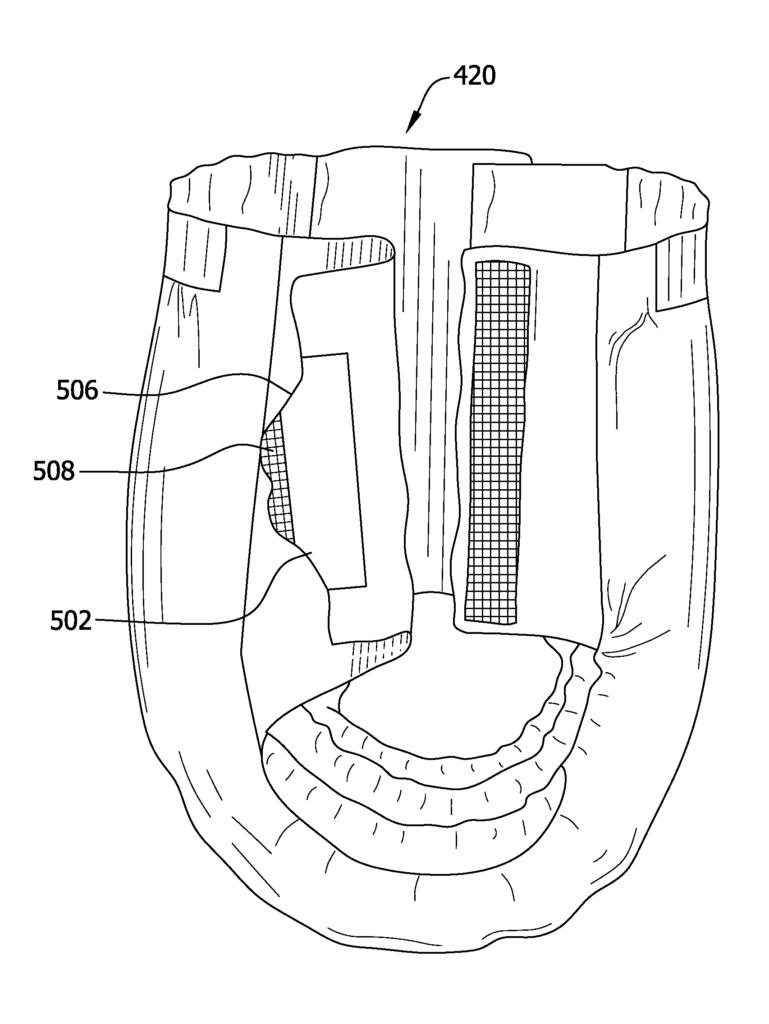
The Kimberly Clark Worldwide Inc invention works as follows
An absorbent article consists of a liquid permeable bodyside lining for facing the wearer, a cover for facing away and an absorbent body that is disposed between the cover and the liner. The primary fastening system for the article is designed to secure it in a wear configuration with a waist opening and two pairs of leg openings. A secondary fastening mechanism consists of a pair tabs with a fastener area that can be selectively attached to the article, and an attachment region that defines a portion the primary fastening systems.
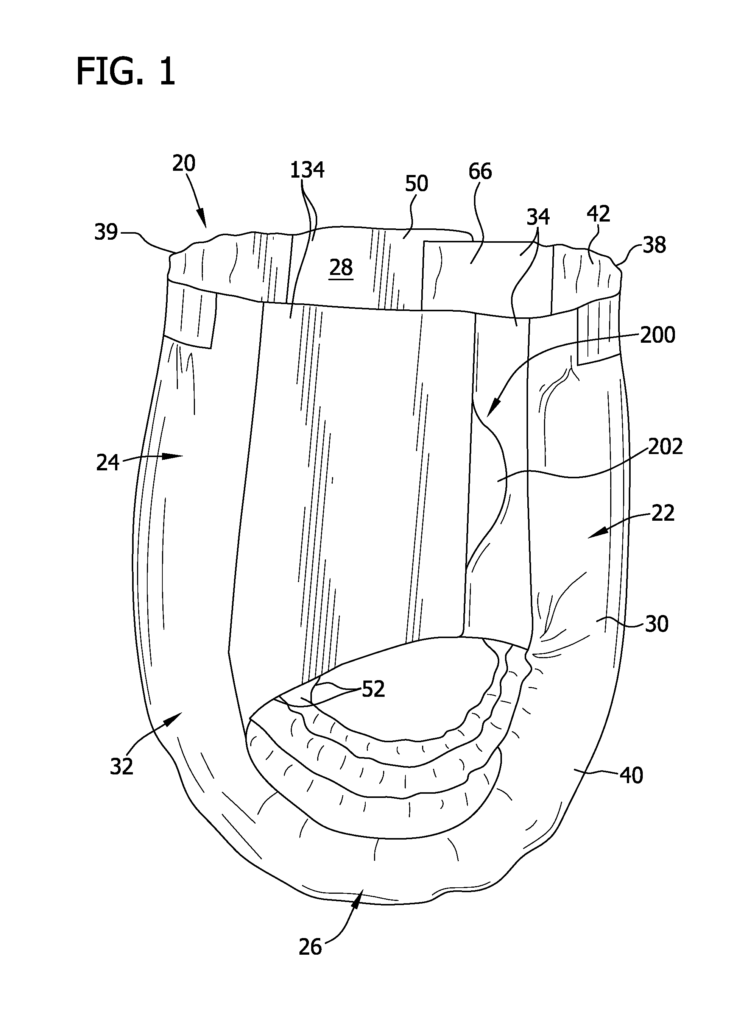
Background for Personal wear absorbent article for tab
The invention generally relates to absorbent articles for personal use, but more specifically to disposable absorbent items.
Many absorbent articles are intended to be used for personal use, including diapers, training pants and feminine hygiene products as well as adult incontinence products. They can also pull moisture from liquid exudates such blood, urine, and menstrual fluids. To reduce irritation from prolonged wetness, the garment should be kept away from the wearer. For example, diapers are placed on the wearer with a set or primary fastening tabs. These can be adhesive tabs or mechanical (e.g. hook or loop), fastening system tabs. They are left in place to absorb insults and contain fecal matter. The caregiver may fold the diaper into a smaller size and then secure it using the primary fastening tabs.
Training pants are typically pre-assembled in a fashion that is more similar to conventional underpants than diapers. To define a wear configuration for pants with a waist opening or leg openings, the front and back waist regions are usually attached permanently to training pants.
Pop-opens (separation) of fasteners can occur in articles that are refastenable such as diapers or training pants. This is due to the stresses placed on the attachment from movement. When a refastenable design is used for training pants, the pants can be taken off without being unfastened. This will also leave no fasteners to keep the pants compacted for disposal. The fastening parts are invisible when the pants are on, so the consumer is not aware of their refastenability. For such training pants, a permanent attachment may not be used. There is no fastening system available to keep the pants in a compact configuration.
The fastening tabs on diapers are very small in the longitudinal direction. They are usually longer in the transverse directions, as they are used to wrap the diaper around the wearer and secure the diaper to the front. Because the sides of a diaper are very short (e.g. from the waist opening to the leg opening), it is easy to control the sides with the small fastening tabs on diapers. Training pants’ sides are generally longer than diapers’ and can be difficult to control with a tab that is as small as the one on diapers.
In addition, the sides and panels of training pants (e.g. side panels) are often designed to be extremely flexible to allow the wearer freedom of movement while still maintaining a comfortable fit. This flexibility makes it more difficult to manipulate the sides of the training pant (for resizing, disposal, etc ).
There is a need for a disposal system for an absorbent article like training pants. This will provide improved resistance to pop-opens and secure the article in a compact configuration. It will also allow the consumer to be aware of the existence of such a fastening device and enable them to use it.
An absorbent article for personal use around a wearer’s waist typically comprises a central absorbent arrangement comprising a liquid permeable outer layer for facing the wearer, and an inner layer for facing away from him/her, and an absorbent body disposed between them. There is also a front waist area, back waist region, and crotch regions that extend longitudinally between the front and back waist regions. The central absorbent assembly’s back waist region is surrounded by a pair of transversely placed panels. To create a wear configuration, the panels attach to the central absorbent assembly’s front waist region. A tab from a pair of tabs is attached to one panel with an attachment region and a tab area that extends transversely beyond the attachment region. Each panel is attached directly to the front waist area of the central absorbent assemblies in the wear configuration. This is done by engaging fastener parts mounted on the central absorbent assemblies front waist region with the attachment region for the tabs. Each tab’s tab is attached directly to the central absorbent assembly’s front waist region in the wear configuration. Fastener components are mounted on each tab.
An absorbent article for personal use around a wearer?s waist generally comprises: a liquid permeable bodilyside liner that faces the wearer, an outer covering that faces away, and an absorbent body between the liner, the cover, according to another aspect. Further, the article includes a front waist area, a back waist region, and a crotch that extends longitudinally between the front and rear waist regions. The first fastening system allows you to attach the back waist area directly to your front waist. It includes a pair spaced apart hook fastening parts mounted on the front region, and a pair loop fastening pieces mounted on the back region. These components can be used for selectively receiving hook fastening elements. The second fastening system consists of a pair tabs, with each tab being attached to the back waist area of the article to create an attachment region for each tab. Each tab is equipped with a hook fastener that extends transversely from the attachment area. Each hook fastener can be releasably attached to loop fasteners located on the front waist to attach the back region of the waist to the front. Each attachment region defines a part of the first fastening method. When the back waist is attached to the front region by both the first or second fastening systems, the tabs’ hook fasteners are closer to the longitudinal centerline than the components mounted on the tabs.
Another aspect of an absorbent article is that it can be worn around the waist by a person. It generally includes a liquid permeable bodyside lining for facing the wearer, a cover for facing away and an absorbent body between the cover and the liner. The primary fastening system for attaching the article to a wear configuration that has a waist opening and two leg openings is provided. A secondary fastening mechanism consists of a pair tabs with a fastener area that can be selectively attached to the article, and an attachment region that defines a portion the primary fastening systems.
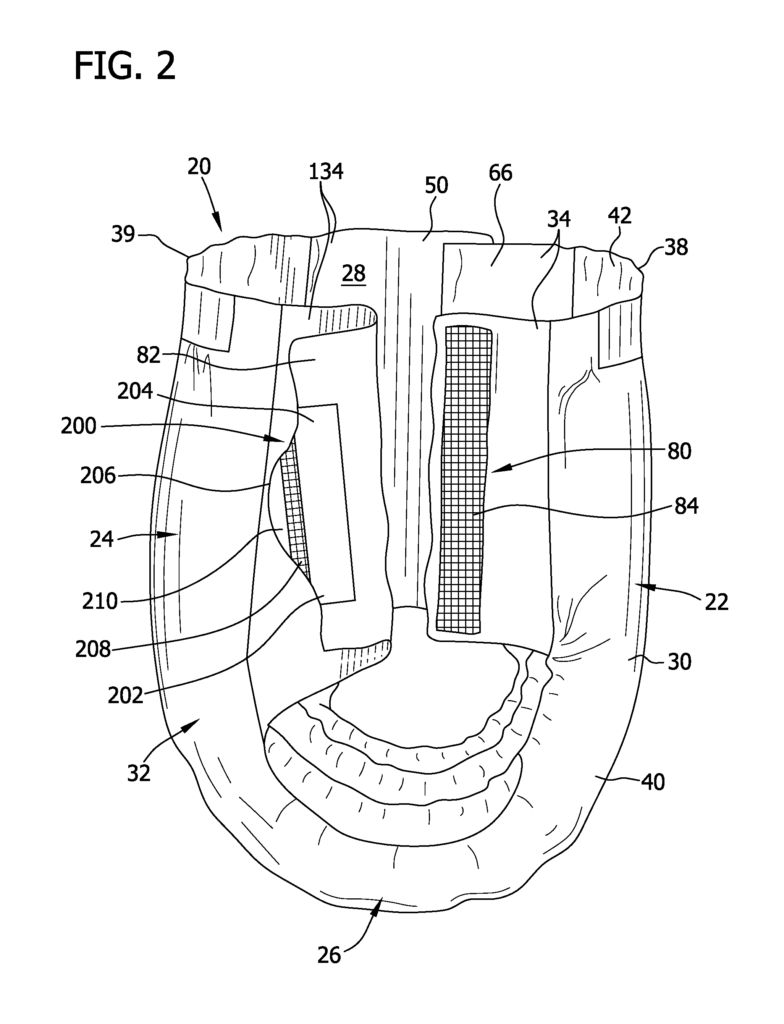
Other features” of the invention will be partly apparent and partially pointed out in this document.
Referring to the drawings, and in particular FIG. 1. A personal wear absorbent article according one embodiment is illustrated as a pants-type article to wear around the waist of the wearer, more specifically in the form children’s toilet training trousers, which are indicated by the reference number 20. Absorbent articles are generally placed on or near the body of the wearer in order to absorb and/or retain liquid wastes. Articles that are disposable may be used to refer to articles that can be thrown away after a short period of time, rather than being washed or restored for another use. The concepts described herein can be used with other pants-type articles like adult incontinence articles and other articles for personal use such as clothing, diapers and feminine hygiene products, medical articles, surgical pads, bandages and other personal care or healthcare garments.
By way only of illustration, different materials and methods for building the training pants 20 are disclosed by PCT Patent Application (WO 00/37009), published Jun. 29, 2000 by A. Fletcher et al; U.S. Pat. No. 4,940,464 July. 10, 1990 to Van Gompel and al. 10, 1990 to Van Gompel et al. No. No. 5,766,389 issued June. 16, 1998 to Brandon and al.
FIG. 20 shows the pair of training pants 20. FIG. 1 shows the pair of training pants 20 in fully assembled (i.e. as it was during initial manufacture) condition. FIG. 2 shows the pants in wear configuration, which is also known as an absorbent article. FIG. 2 in partially unfastened conditions. The training pants 20 have a front waist area 22 and a back waist region 24. A crotch 26 extends longitudinally between the front and back waist regions. An inner surface 28 is designed for contiguous relation with the wearer. The outer surface 30 is opposite. Refer to FIGS. 3. and 4. The training pants 20 have a pair each of 36 and 39 laterally opposite side edges. A pair of longitudinally opposed waist edges are also included, which are designated respectively as the front waist edge 38 or back waist edge 39. The front waist area 22 is adjacent to the front edge 38 and the back waist is contiguous to the back edge 39.
The illustrated pants 20 include a central absorbent assembly (generally indicated at 32), which is laid flat as shown in FIGS. The shape of 3 and 4 may be any type you desire. The absorbent assembly 32 at front waist area 22 is flanked by a pair of laterally opposing front side panels 34. This forms transversely outside portions of the front waist and, more generally, the transversely opposite sides to the training pants. The 134 laterally opposite rear side panels extend outwards from the absorbent 32 at the back region 24 (thereby creating transversely outer portions and more broadly defining the sides the training pants).
The central absorbent assembly 32 in the illustrated embodiment consists of an outer cover 40 (FIGS.) and a bodyside liners 42 (FIGS. 1, and 2, are connected to the outer covering in a superposed relationship by suitable means, such as adhesives or thermal bonds, or other conventional methods. An absorbent structure 44 (FIG. Between the outer cover, the bodyside liner and the absorbent structure 44 (FIG.4) Two containment flaps 46 are shown in FIG. For preventing the lateral flow exudates, a pair of containment flaps 46 (FIG. The opposite ends of the central absorbent assembly 32 form portions of the front, back and waist edges 38 and 39 respectively. 47 on the other hand form portions the sides 36 and 37 of the training pants 20 (FIGS. 3, and 4).
The absorbent assembly 32, and side panels 34,134 can be composed of two or more elements, as shown at FIGS. 1, 2, or both, they can be combined as shown in FIG. 9. Side panels 34,134, and 32 are integrally formed. They would contain at least some common materials such as the bodyside liners, flap composites, outer covers, and other covers. This could be used to define one-piece elastic, stretchable or non-stretchable pants 20. Further reference is provided by the arrows 48-49 in FIGS. The orientations of the longitudinal axis of the training pants 20 and the transverse or lateral of the training pants 20 are shown in FIGS. 3 and 4.
With the training pant 20 in the fastened condition, as illustrated in FIG. 1. and FIG. 2 The front and back sides 34, 134 are connected to one another by a primary, also known as an article fastening system 80. This allows for the three-dimensional pre-assembled wear configuration of the pants. They have a waist opening of 50 and a pair 52 of leg openings. The portion of training pants 20 that is worn at least partially on the front is the front waist area 22. The back waist region 24, on the other hand, is the portion of training pants 20 that is worn at least partially on the back. The portion of the training pant 20 that is between the legs and covers the lower part of the wearer’s torso is the crotch area 26.
The front and back sides panels 34 and 134 are the portions of the training pant 20 (and in particular the front and rear waist regions 22, 24, respectively) that, when worn, are placed on the wearer’s hips. Attached side panels 34 and 134 define the transversely opposing sides of the pants 20. Each side extends a length Lp. (FIG. 5) between the waist opening 50 and the respective leg opening 52 at an Engagement seam 66, along which the fastening 80 attaches the back and front side panels. The waist edges 38 of the training pants 20 and 39 of the trousers 20 are designed to wrap around the waist and define the 50-inch opening (FIG. 1). The leg openings 52 are generally defined by the portions of the 36-inch side edges in the crotch area 26.
The central absorbent assembly 32 is designed to absorb and contain exudates that are discharged from the wearer. The 46 containment flaps are designed to prevent the transverse flow exudates. FIG. 53 shows a flap elastic member 53. A flap elastic member 53 (FIG. To seal the body, the elasticized containment flaps 46 have a partially unattached edge that assumes an upright position in the crotch 26 of the training pants 20. The containment flaps 46 are located along the 36-inch side edges of the pants 20. They can be found along the absorbent 32’s length or only partially. The suitable constructions and arrangements of the containment flaps 46 can be found in U.S. Pat. No. No.
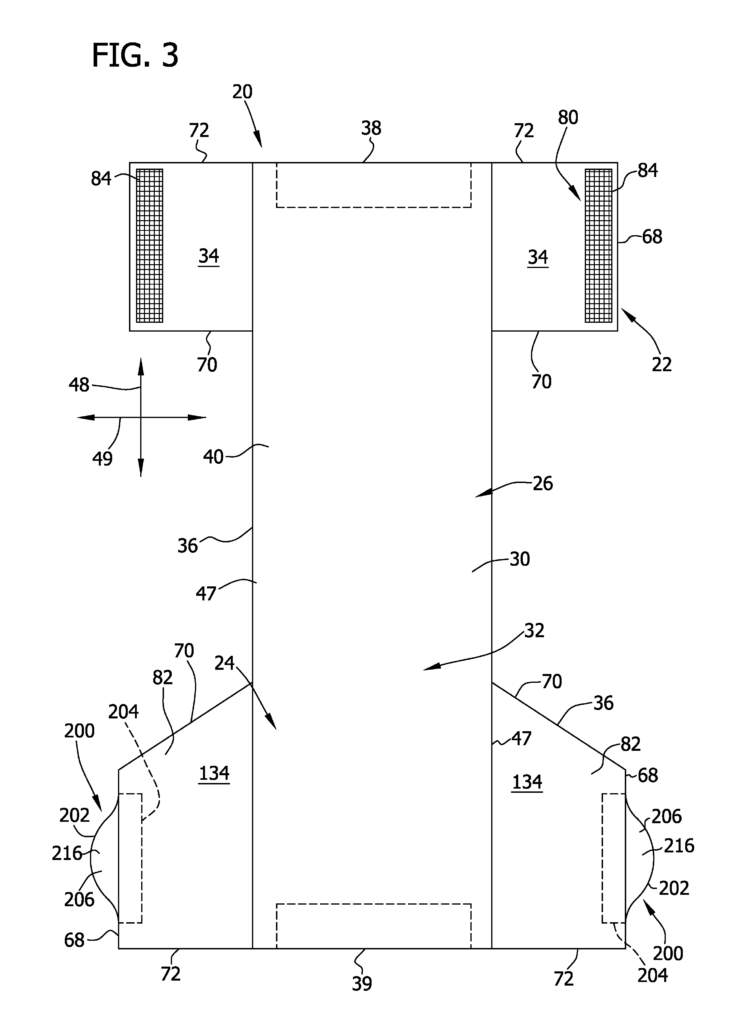
The training pants 20 include a 54-inch front waist elastic member (FIG. 4), a rear elastic member 56, and leg elastic parts 58. These are all known to those who are skilled in the art. The waist elastic members 54, 56 and 42 can be attached to either the outer cover 40 or the bodysideliner 42 at the opposite waistlines 38 and 39. They can extend over a portion or all of their waist edges. Leg elastic members 58 can attach to the outer cover 40 or 42 along the opposite side edge 36. They can then be positioned in the crotch area 26 of the training pant 20. Leg elastic members 58 can also be placed longitudinally along the side edges 47 and 32 of the absorbent system 32.
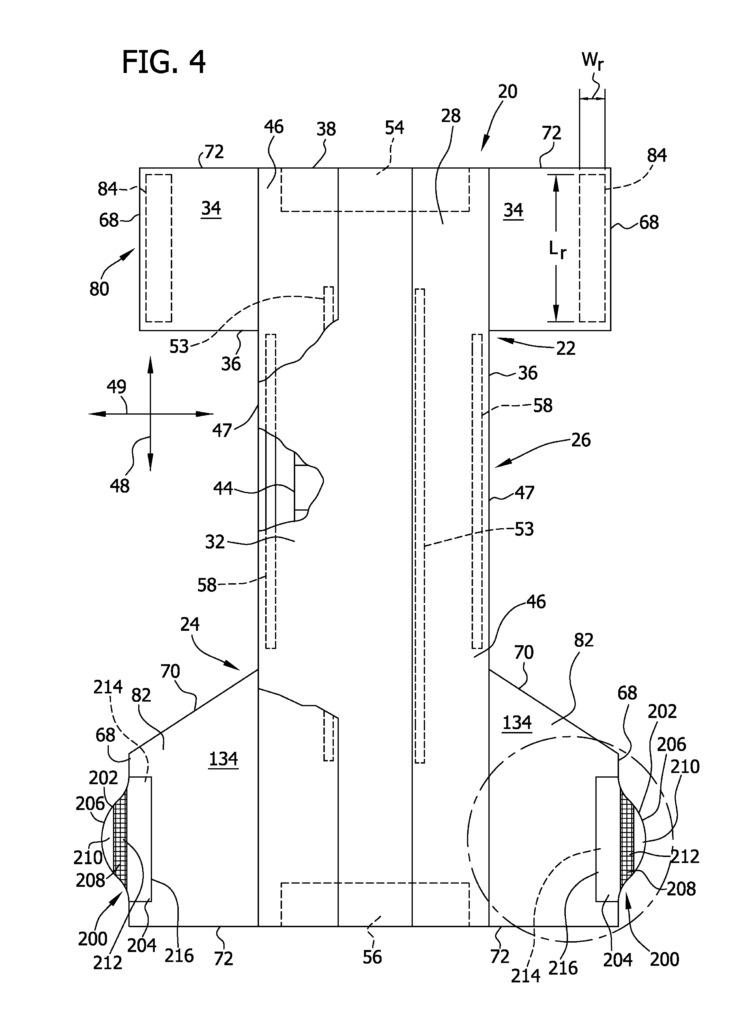
Click here to view the patent on Google Patents.
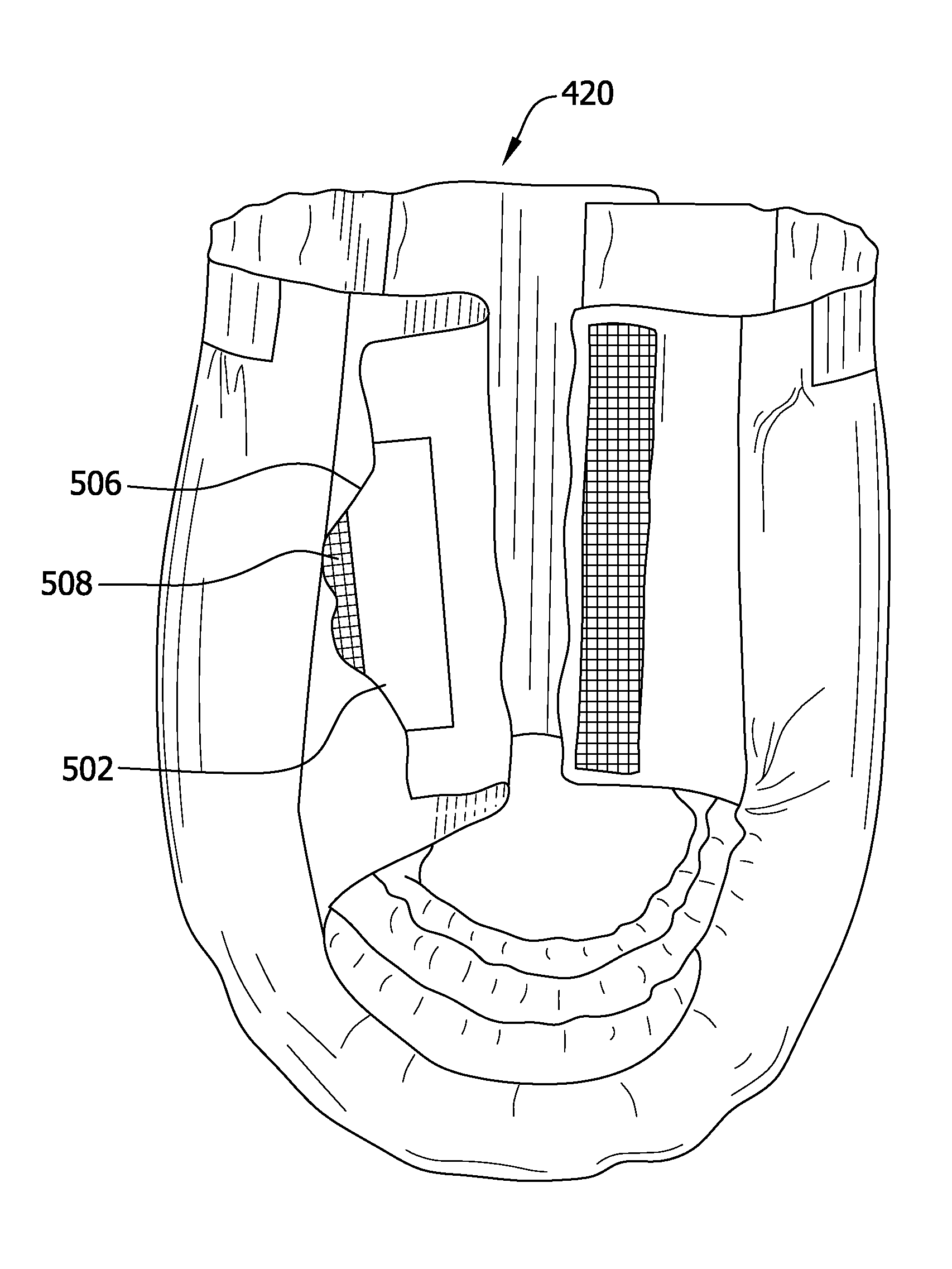
Leave a Reply